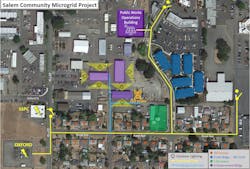Resilience-hungry Oregon to deploy two community microgrids, reflecting national trend
Oregon, which is experiencing drought, hot summer temperatures, intense winter storms, wildfires and public safety power shutoffs, is set to deploy two community microgrids – one in Salem, the state capital, and the other in Ashland.
The Salem project expands Portland General Electric’s (PGE) ongoing experiments in partnering with cities, the military and other customers. In Ashland, the $940,000 community resilience project will be fully funded by the Oregon Department of Energy (ODOE). Resilience is important to Ashland, which in 2020 was hit by the Alameda Fire – the most destructive fire in Oregon’s history. The fire destroyed more than 2,600 homes in the region.
The rise of community microgrids
Nationally, community microgrids have been slow to take off, in part because of limited community engagement, the use of nonrenewable generation technologies, financing challenges and the lack of metrics for valuing microgrid resilience, according to a study from Oregon State University.
But that’s beginning to change with new models emerging. For example, a nested community microgrid was unveiled recently in Menifee, California, and buyers have already contracted for 58 of the roughly 200 homes to be built in two KB Home neighborhoods. Each home has its own nanogrid that is connected to a central microgrid. The central microgrid connects the two neighborhoods for energy sharing.
And residential solar company Sunnova Energy took the unusual step recently of seeking regulatory approval in California to act as a utility that owns and operates community microgrids.
PGE's unique model
PGE’s model is also relatively unique. During energy emergencies PGE makes use of energy storage situated on the premises of its customers, said Darren Murtaugh, senior manager of grid edge solutions for PGE. Under two PGE pilot partnerships, the utility owns and deploys batteries behind the meter at customer sites, and the customers provide solar and other on-site resources to create microgrids. At the Beaverton Public Safety Center, the microgrid includes 250 KW/1,000 kWh of battery storage – owned by PGE. Part of the microgrid and owned by the city are 300 kW of solar and a 1-MW diesel standby generator.
At the Anderson Readiness Center in Salem – a PGE customer – PGE will own and operate a 500-kW/1-MWh battery that will be part of the microgrid. The Oregon Military Department recently completed installing 268 kW of solar photovoltaics at the Anderson Readiness Center, which the military will own as part of the microgrid.
The latest in this series of PGE partnerships is the Salem community microgrid, which will serve Salem's Public Works building, 96 units in six apartment buildings, 34 homes, four government buildings and one business during outages.
The microgrid includes a 5-MW battery owned by PGE located at PGE’s Smart Power Center – a project that aims to demonstrate the benefits of storage.
Also included is an inverter system. The battery and inverter are part of the Pacific Northwest Smart Grid Demonstration Project, a US Department of Energy (DOE) research effort.
In addition, about 200 kW of solar located on the new Salem Public Works building will be part of the community microgrid. The public works building will have a backup diesel generator for emergencies, said Murtaugh.
One of the unique characteristics of the microgrid is that the PGE-owned battery and city-owned solar are not co-located, said Trevor Smith, public information officer for the city. They’re located a few blocks from each other.
The location was chosen to provide resilience for the Public Works Operations building, which is under construction and expected to be complete in the fall of 2023, and because of its proximity to PGE’s Smart Power Center, said Smith. The microgrid is also located in a mix of separate government buildings, apartments and homes and is situated in an underserved community. It will serve a high percentage of people of color, seniors and people living below the poverty level, said Smith.
Funding & cost savings
Half of the Salem microgrid was funded with a $1 million grant from the ODOE’s Community Renewable Energy Grant Program and the other half is funded by ratepayers, said Murtaugh. Part of the funding will pay for the automatic switching and controls needed to isolate from the region of the gridthat is served by the microgrid and manage the microgrid, he said.
The ratepayer funding is justified because the project serves customers and lowers PGE’s costs, said Murtaugh.
“We get a lot of value out of this resource as well as the city of Salem,” he said about the battery located at the Salem Smart Power Center. “When there’s no outage, we get contingency reserve, emergency replacement power, frequency response and grid services that we extract from the battery every day.” The battery has been PGE’s most dependable resource.
“The traditional resources we used to depend on to provide frequency response pale in response to the battery,” Murtaugh added. PGE has used the battery two to five times a month for short durations – a few minutes. That’s all that’s generally needed to support frequency response, he said.
Because the battery was deployed at the Salem Smart Power Center in 2012, it has saved PGE and customers about $400,000 annually, said John Farmer, spokesman for PGE.
More microgrids coming
The city of Salem’s Climate Action Plan includes developing more microgrids that can serve neighborhoods that have essential infrastructure, Smith said.
Another PGE partnership is a microgrid at Portland’s Fire Station 1. PGE has also launched a residential pilot program under which customers buy their own batteries – in some cases, at a discount – that can be aggregated and utilized by PGE.
Farther south, in Ashland – known as a tourist destination and retirement community – the city is no stranger to the need for resilience, said Denise Deneaux, community outreach coordinator for Stracker Solar, which is developing the community microgrid.
The city experienced communication challenges during the 2020 Alameda Fire, which affected the fire and police departments’ ability to respond to calls for help, she said.
The Ashland microgrid, which is expected to generate 170,000 kWh of electricity each year, will include a 75-kW dual-axis solar tracking system and lithium battery storage. The installation will be located at the City Service Center and will provide energy resilience for the city’s police and electric departments, as well as a fiber network, in case of a grid outage. That’s important, given the communications challenges wrought by the Alameda Fire.
The microgrid will serve a number of seniors and people in low-income communities, Deneaux added.
Those residents will benefit from the solar installation, said Jeff Sharpe, COO, principal engineer and founder of Stracker Solar. Under a virtual net metering program, the solar credits are expected to go to low-income residents. The city is served by the Ashland Municipal Electric Utility.
Batteries from an expanding fleet of electric vehicles in Ashland will be included as resources in the microgrid, said Sharpe. Initially, 480-volt, level 3 charging stations will be included in the project. It’s expected that when bidirectional charging becomes more available, the batteries will be used as a resource to back up internet in the building. They’ll also be used to power essential services during outages, said Sharpe.
“We’ll turn DC-stored energy into 480-volt energy and handle more essential services with the batteries,” he said.
Modeling resiliency
The Ashland and Salem community microgrids are seen as examples of how to create resiliency in Oregon and other states that are suffering from the effects of climate change.
In Salem, for example, designing resiliency into the Public Works building while it’s being built will yield important advantages, said Jeni Hall, advanced solar program manager at Energy Trust of Oregon, a nonprofit organization that helps individuals and businesses adopt clean energy.
“The building is an outstanding example of how to build for resiliency and to set that goal at the outset. Energy efficiency, solar and battery storage were planned from the beginning of the project, through Energy Trust of Oregon's New Buildings Path to Net Zero offering, to maximize the building’s resilience," she said.
Track news about renewable microgrid projects. Subscribe to the free Microgrid Knowledge Newsletter.








